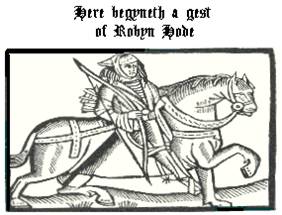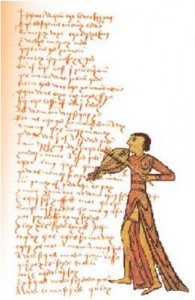I admit it- I had a lot of fun writing my latest novel, Romancing Robin Hood. It gave me the chance to take a self indulgent trip down memory lane, and dig out all my PhD notes on the ballad history behind the Robin Hood legend. Although my novel is a modern contemporary romance, it also contains a second story- a medieval mystery which has more than a hint of the Robin Hood’s about it.
The earliest balladeers sang tales of Robin Hood long before they were written down, and audiences through history have all had different ideas of what Robin Hood was like in word, action, and appearance. Every writer, film maker, and poet ever since the first tales were spoken, has adapted the outlaw figure to fit their own imagination.
The earliest mention found (to date), of the name Robin Hood appears in the poem The Vision of Piers Plowman, which was written by William Langland in c.1377.
A long ballad, Piers Plowman was a protest against the harsh conditions endured by the poor in the Fourteen Century. Not only did it mention Robin Hood, but makes reference to he outlaw gang, the Folvilles, who research suggests were an influence on those whose exploits wrote the Robin Hood ballads.
“And some ryde and to recovere that unrightfully was wonne:
He wised hem wynne it ayein wightnesses of handes,
And fecchen it from false men with Folvyles lawes.”
The Folville family were incredibly dangerous, influential, and had great impact on the Midlands of the UK in the Fourteenth Century. I’ll be introducing this family of brothers to you properly very soon; for they are something of an obsession for historian Dr Grace Harper- the lead character in Romancing Robin Hood.
In 1450 the earliest single short ballad, Robin Hood and the Monk, was committed to paper, but it wasn’t until 1510 that the original story (Lytell Geste of Robyn Hode), was recorded in its entirety.
With the arrival of the printing press in Tudor and Elizabethan times, all of the most popular stories we recognise today were recorded for prosperity. Some of these stories had medieval roots, but many were were brand new pieces. The Tudor audience was as keen for fresh tales containing their favourite heroes as we are today. These ‘new’ tales included Robin Hood and Gisborne (c.1500) and Robin Hood and the Curtal Friar (c.1550) – who became known as Friar Tuck.
The Tudors loved the stories of Robin Hood. He was more popular then than he is now. Tudor documents are littered with mentions of Robin Hood’s all over Britain. For example-
– in 1497 Roger Marshall called himself Robin Hood, and lead a riot of 200 men in Staffordshire.
– in 1509, ten Robin Hood plays were banned in Exeter by the city council, as they had become a public nuisance.
Robin Hood’s most famous Tudor fan was Henry VIII himself. In fact, apart from hunting, eating, and getting married, Henry’s favourite hobby was acting. Sometimes he dressed up as Robin Hood. The king would wear a mask, and his audience had to pretend they didn’t know it was him, and had to look surprised when he revealed his true identity at the end of the play.
In 1510 Henry VIII and eleven of his nobles dressed as Robin Hood and broke into the Queen’s private rooms, apparently giving her the fright of her life! (Up to that point anyway!)
Thank you for letting me share a little of my Robin Hood passion with you today- be warned, there will be more on the subject very soon….
Romancing Robin Hood is available now on Nook, Kobo, Kindle and in paperback from all good retailers, including-
Happy reading,
Jenny xx



Miss Philippa
Can’t wait to read it! I did a four month contract performing at a Medieval Banquet, it was so painfully historically inaccurate that I learnt to hate the place. It has really made me enjoy plays and books where history is actually studied and used correctly!! Your book sounds really interesting, so can’t wait to get my teeth into it!
Jenny Kane
Thanks so much! I know what you mean about Medieval Banquets- lots of fun at face value, but a historical experience they are not! I had the best time ever doing my PhD- so much fun using my study notes again! xx
Miss Philippa
Can’t wait to read it! I did a four month contract performing at a Medieval Banquet, it was so painfully historically inaccurate that I learnt to hate the place. It has really made me enjoy plays and books where history is actually studied and used correctly!! Your book sounds really interesting, so can’t wait to get my teeth into it!
Jenny Kane
Thanks so much! I know what you mean about Medieval Banquets- lots of fun at face value, but a historical experience they are not! I had the best time ever doing my PhD- so much fun using my study notes again! xx
richard wagner
I have a question, Ms Kane. I was reading, just the other day, that Robin was gay.
Professor Stephen Knight wrote a piece claiming that the twelfth century folk hero Robin Hood was a poof. Knight, who until recently was Distinguished Research Professor at the University of Cardiff in Wales, claimed that Robin of Locksley was a victim of anti-Gay prejudice who was forced to live in Sher-wood Forest with his band of ‘merry men.’
After studying ballads of Robin Hood written in the fourteenth century, Knight concluded that ‘the ballads could not say outright that he was gay because of the prevailing moral climate, but they do contain a great deal of erotic imagery. The green wood itself is a symbol of virility and the references to arrows, quiv-ers and swords make it clear, too.’ Knight added that Maid Marian was a ‘beard’ who was not part of the legend until the sixteenth century and that Robin’s real love was ‘Little John,’ one of his ‘merry men.’
Though Knight’s theories seem far-fetched, even to me, the very merry British group Outrage welcomed the ‘outing’ of Robin Hood: ‘It is about time school history lessons acknowledged the contributions of famous homosexuals.’
Jenny Kane
Funny, but I’ve read most of Professor Knight’s work, but that’s a new theory on me! Still- I don’t see why not- Robin Hood can, after all, be anything we want him to be. That’s what makes him such a wonderful folk hero for any period in history. And let’s not forget, that the most popular version of RH spent all his time in the woods with a load of men…Maid Marian being a rather late addition to the ballads…off to hunt down Knight’s latest works…. xxx
richard wagner
as much as i find the idea of Robin being gay, my favorite Robin is Sean Connery in Robin And Marian. http://www.imdb.com/title/tt0075147/ Audrey Hepburn could have turned me straight. i watch this movie at least once a year and weep every time.
Jenny Kane
It’s a brilliant film- def one of the best. Heart breaking though xx
richard wagner
I have a question, Ms Kane. I was reading, just the other day, that Robin was gay.
Professor Stephen Knight wrote a piece claiming that the twelfth century folk hero Robin Hood was a poof. Knight, who until recently was Distinguished Research Professor at the University of Cardiff in Wales, claimed that Robin of Locksley was a victim of anti-Gay prejudice who was forced to live in Sher-wood Forest with his band of ‘merry men.’
After studying ballads of Robin Hood written in the fourteenth century, Knight concluded that ‘the ballads could not say outright that he was gay because of the prevailing moral climate, but they do contain a great deal of erotic imagery. The green wood itself is a symbol of virility and the references to arrows, quiv-ers and swords make it clear, too.’ Knight added that Maid Marian was a ‘beard’ who was not part of the legend until the sixteenth century and that Robin’s real love was ‘Little John,’ one of his ‘merry men.’
Though Knight’s theories seem far-fetched, even to me, the very merry British group Outrage welcomed the ‘outing’ of Robin Hood: ‘It is about time school history lessons acknowledged the contributions of famous homosexuals.’
Jenny Kane
Funny, but I’ve read most of Professor Knight’s work, but that’s a new theory on me! Still- I don’t see why not- Robin Hood can, after all, be anything we want him to be. That’s what makes him such a wonderful folk hero for any period in history. And let’s not forget, that the most popular version of RH spent all his time in the woods with a load of men…Maid Marian being a rather late addition to the ballads…off to hunt down Knight’s latest works…. xxx
richard wagner
as much as i find the idea of Robin being gay, my favorite Robin is Sean Connery in Robin And Marian. http://www.imdb.com/title/tt0075147/ Audrey Hepburn could have turned me straight. i watch this movie at least once a year and weep every time.
Jenny Kane
It’s a brilliant film- def one of the best. Heart breaking though xx